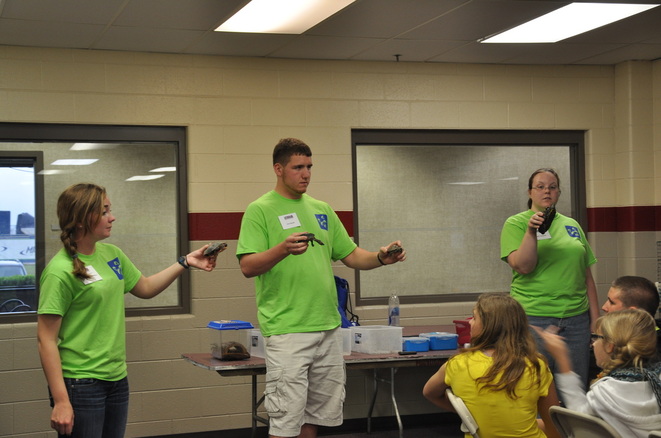Animal Encounter
During this experience, students have an up-close and personal encounter with wild animals that populate Southeastern Michigan. Adrian College Teacher Education and Biology students that are trained to care for the animals take the opportunity to share them with visiting students. The students have a hands-on opportunity to learn how animals care for themselves in the wild and what we should do to protect and preserve their natural habitat. They will gain an understanding in the conservation laws and learn what different types of animals are and how to classify them.
Students who wish to touch the animals will get a hands-on opportunity with the animals after learning the proper way to handle them. Students can choose whether or not they wish to touch the animals, but all students get an equal opportunity to gain important knowledge about each animal.
Students walk away from this experience with knowledge of how to handle and care for animals as well as ideas of classifications of animals. Students will also be able to correct false myths about animals important to nature.
Students who wish to touch the animals will get a hands-on opportunity with the animals after learning the proper way to handle them. Students can choose whether or not they wish to touch the animals, but all students get an equal opportunity to gain important knowledge about each animal.
Students walk away from this experience with knowledge of how to handle and care for animals as well as ideas of classifications of animals. Students will also be able to correct false myths about animals important to nature.
Click the links below to view information on some of our animals
Animals
|
Animals #1
Students will complete an activity in teams where they explore the differences between invertabrates and vertabrates along with the different characteristics of each of the five classes of vertebrates. Students will then be introduced to various members of our live animal collection. Students will be taught about different defense mechanisms, predators and prey, and other adaptations and methods of survival that animals use in the wild. |
Animals #2
Students will learn the definitions of a population, community, and ecosystem. An activity will then be completed in teams to help students develop a visual understanding of these terms. Each team will be given a variety of images which they will have the task of placing into their respective locations on a graphic organizer. The five relationships within a community will then be explained. As the lesson's concepts are reviewed, students will be introduced to various members of our live animal collection. |
Benchmarks Covered
5-PS3- 1
Use models to describe that energy in animals’ food (used for body repair, growth, motion, and to maintain body warmth) was once energy from the sun.
5-LS2- 1
Develop a model to describe the movement of matter among plants, animals, decomposers, and the environment.
MS-LS1- 6
Construct a scientific explanation based on evidence for the role of photosynthesis in the cycling of matter and flow of energy into and out of organisms.
MS-LS2- 1
Analyze and interpret data to provide evidence for the effects of resource availability on organisms and populations of organisms in an ecosystem. AE
MS-LS2- 3
Develop a model to describe the cycling of matter and flow of energy among living and nonliving parts of an ecosystem.
MS-LS2- 4
Construct an argument supported by empirical evidence that changes to physical or biological components of an ecosystem affect populations.
Interdependent Relationships in Ecosystems
MS-LS2- 2
Construct an explanation that predicts patterns of interactions among organisms across multiple ecosystems.
MS-LS1- 4
Use argument based on empirical evidence and scientific reasoning to support an explanation for how characteristic animal behaviors and specialized plant structures affect the probability of successful reproduction of animals and plants respectively.
Use models to describe that energy in animals’ food (used for body repair, growth, motion, and to maintain body warmth) was once energy from the sun.
5-LS2- 1
Develop a model to describe the movement of matter among plants, animals, decomposers, and the environment.
MS-LS1- 6
Construct a scientific explanation based on evidence for the role of photosynthesis in the cycling of matter and flow of energy into and out of organisms.
MS-LS2- 1
Analyze and interpret data to provide evidence for the effects of resource availability on organisms and populations of organisms in an ecosystem. AE
MS-LS2- 3
Develop a model to describe the cycling of matter and flow of energy among living and nonliving parts of an ecosystem.
MS-LS2- 4
Construct an argument supported by empirical evidence that changes to physical or biological components of an ecosystem affect populations.
Interdependent Relationships in Ecosystems
MS-LS2- 2
Construct an explanation that predicts patterns of interactions among organisms across multiple ecosystems.
MS-LS1- 4
Use argument based on empirical evidence and scientific reasoning to support an explanation for how characteristic animal behaviors and specialized plant structures affect the probability of successful reproduction of animals and plants respectively.

